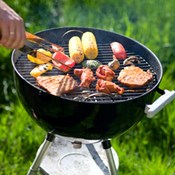Cooking out requires extra care to prevent food-borne illness, says LSU AgCenter nutritionist Beth Reames. Careful grilling also can prevent excessive smoke and charring that may be unhealthful.
For safe cookouts, Reames recommends these tips for proper cleanliness, safe food preparation and healthful grilling:
Thaw safely.
- Completely thaw meat and poultry before grilling so it cooks more evenly. Use the refrigerator for slow, safe thawing or thaw sealed packages in cold water. You can use a microwave to defrost if the food will be placed immediately on the grill.
Marinate.
- Marinate raw meats, fish or poultry in the refrigerator, not on the counter. Set aside a portion of the marinade before adding raw meat or poultry to use later as a sauce. If you reuse the marinade from the raw meat, bring it to a rolling boil to kill any bacteria.
Precook.
- Precooking food partially in the microwave, oven or stovetop is a good way to reduce grilling time. Just make sure the food goes immediately on the preheated grill to complete cooking.
Have the grill ready.
- Make sure the grill is ready. For safety and quality, make sure that the coals are very hot before cooking food. This can take 30 minutes or longer.
- If dripping fat causes heavy smoke while grilling, move the food to another section of the grill, rotate the grill or reduce the heat.
Control the fire.
- Cook meat until it is done, but do not char it. Remove any charred or burned material from the food's surface. Do not eat the charred parts.
- Thoroughly cook all meat and poultry. Because meat and poultry cooked on a grill often brown very fast on the outside, use a meat thermometer to ensure meat is cooked thoroughly.
- To use a meat thermometer properly, insert it into the thickest part of the meat, being sure the end of the thermometer doesn’t rest on the cooking surface. Beef, veal and lamb can be cooked to 145 degrees, and ground beef should reach 160 degrees. Other minimum temperatures should be 160 degrees for pork and 165 degrees for poultry. Grill fully cooked meats like hot dogs by heating them to 165 degrees or until they’re steaming hot.
Serve safely.
- When taking food off the grill, use a clean platter. Don't put cooked food on the same platter that held raw meat or poultry. Any harmful bacteria present in the raw meat juices could contaminate safely cooked food.
- Keep grilled meat and poultry hot until served – at 140 degrees or warmer. Keep cooked meats hot by setting them to the side of the grill rack, not directly over the coals where they could overcook. Cooked meat also can be kept hot in an oven set at approximately 200 degrees, in a chafing dish or slow cooker, or on a warming tray.
Store leftovers properly.
- Refrigerate any leftovers promptly in shallow containers. Discard any food left out more than two hours – or one hour if temperatures are above 90 degrees.







